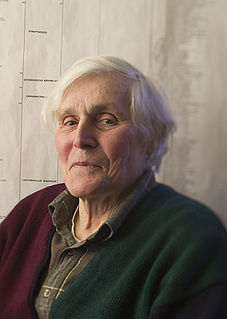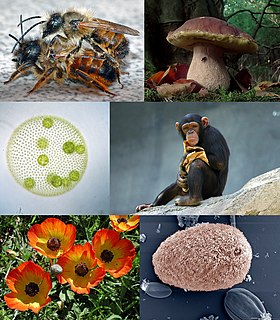
A cell wall is a structural layer surrounding some types of cells, just outside the cell membrane. It can be tough, flexible, and sometimes rigid. It provides the cell with both structural support and protection, and also acts as a filtering mechanism. Cell walls are present in most prokaryotes, in algae, fungi and eukaryotes including plants but are absent in animals. A major function is to act as pressure vessels, preventing over-expansion of the cell when water enters.

A clade, also known as a monophyletic group or natural group, is a group of organisms that are monophyletic—that is, composed of a common ancestor and all its lineal descendants - on a phylogenetic tree. Rather than the English term, the equivalent Latin term cladus is often used in taxonomical literature.

Howland Island is an uninhabited coral island located just north of the equator in the central Pacific Ocean, about 1,700 nautical miles (3,100 km) southwest of Honolulu. The island lies almost halfway between Hawaii and Australia and is an unincorporated, unorganized territory of the United States. Together with Baker Island it forms part of the Phoenix Islands. For statistical purposes, Howland is grouped as one of the United States Minor Outlying Islands. The island has an elongated banana-shape on a north–south axis, 1.40 by 0.55 nautical miles, and covers 2.6 square kilometres.

John the Evangelist is the name traditionally given to the author of the Gospel of John. Christians have traditionally identified him with John the Apostle, John of Patmos, or John the Presbyter, although this has been disputed by most modern scholars.

A microorganism, or microbe, is a microscopic organism, which may exist in its single-celled form or a colony of cells.

Titus Lucretius Carus was a Roman poet and philosopher. His only known work is the philosophical poem De rerum natura, a didactic work about the tenets and philosophy of Epicureanism, and which usually is translated into English as On the Nature of Things. Lucretius has been credited with originating the concept of the three-age system that was formalised in 1836 by C. J. Thomsen.

Carl Richard Woese was an American microbiologist and biophysicist. Woese is famous for defining the Archaea in 1977 by phylogenetic taxonomy of 16S ribosomal RNA, a technique he pioneered that revolutionized microbiology. He also originated the RNA world hypothesis in 1967, although not by that name. Woese held the Stanley O. Ikenberry Chair and was professor of microbiology at the University of Illinois at Urbana–Champaign.

Lynn Margulis was an American evolutionary theorist, biologist, science author, educator, and science popularizer, and was the primary modern proponent for the significance of symbiosis in evolution. Historian Jan Sapp has said that "Lynn Margulis's name is as synonymous with symbiosis as Charles Darwin's is with evolution." In particular, Margulis transformed and fundamentally framed current understanding of the evolution of cells with nuclei – an event Ernst Mayr called "perhaps the most important and dramatic event in the history of life" – by proposing it to have been the result of symbiotic mergers of bacteria. Margulis was also the co-developer of the Gaia hypothesis with the British chemist James Lovelock, proposing that the Earth functions as a single self-regulating system, and was the principal defender and promulgator of the five kingdom classification of Robert Whittaker.
In biological taxonomy, a domain, also superkingdom, realm, or empire, is the highest taxonomic rank of organisms in the three-domain system of taxonomy devised by Carl Woese et al. in 1990.

The three-domain system is a biological classification introduced by Carl Woese et al. in 1990 that divides cellular life forms into archaea, bacteria, and eukaryote domains. The key difference from earlier classifications is the splitting of archaea from bacteria.

Memoirs of a Woman of Pleasure—popularly known as Fanny Hill —is an erotic novel by English novelist John Cleland first published in London in 1748. Written while the author was in debtors' prison in London, it is considered "the first original English prose pornography, and the first pornography to use the form of the novel". It is one of the most prosecuted and banned books in history.

The last universal common ancestor or last universal cellular ancestor (LUCA), also called the last universal ancestor (LUA), is the most recent population of organisms from which all organisms now living on Earth have a common descent—the most recent common ancestor of all current life on Earth. A related concept is that of progenote. LUCA is not thought to be the first life on Earth, but rather the latest that is ancestral to all current existing life.

Paleobiology is an interdisciplinary field that combines the methods and findings found in both the earth sciences and the life sciences. Not to be confused with geobiology, which focuses more on the interactions between the biosphere and the physical Earth.
William Shakespeare (1564–1616) was an English poet and playwright. He wrote approximately 39 plays and 154 sonnets, as well as a variety of other poems.
David P. Barash is Professor of Psychology emeritus at the University of Washington. He has written, edited or co-authored 40 books, including ones on human aggression, peace studies, and the sexual behavior of animals and people. He received his bachelor's degree in biology from Harpur College, Binghamton University, and a Ph.D. in zoology from University of Wisconsin–Madison in 1970. He taught at the State University of New York at Oneonta and then accepted a permanent position at the University of Washington.

Archaea constitute a domain of single-celled organisms. These microorganisms lack cell nuclei and are therefore prokaryotes. Archaea were initially classified as bacteria, receiving the name archaebacteria, but this term has fallen out of use.

In biology, an organism is an entity capable of carrying on life functions. All organisms are composed of cells. Organisms are classified by taxonomy into groups such as multicellular animals, plants, and fungi; or unicellular microorganisms such as protists, bacteria, and archaea. All types of organisms are capable of reproduction, growth and development, maintenance, and some degree of response to stimuli. Humans, squids, mushrooms, and vascular plants are examples of multicellular organisms that differentiate specialized tissues and organs during development.

Eukaryotes are organisms whose cells have a nucleus enclosed within a nuclear envelope. Eukaryotes belong to the domain Eukaryota or Eukarya; their name comes from the Greek εὖ and κάρυον. The domain Eukaryota makes up one of the three domains of life; the prokaryotes Bacteria and Archaea make up the other two domains. The eukaryotes are usually now regarded as having emerged in the Archaea or as a sister of the now cultivated Asgard archaea. Eukaryotes represent a tiny minority of the number of organisms; however, due to their generally much larger size, their collective global biomass is estimated to be about equal to that of prokaryotes. Eukaryotes emerged approximately 2.1-1.6 billion years ago, during the Proterozoic eon, likely as flagellated phagotrophs.
Life form is an entity that is living, such as plants (flora) and animals (fauna). It is estimated that more than 99% of all species that ever existed on Earth, amounting to over five billion species, are extinct.

Marine prokaryotes are marine bacteria and marine archaea. They are defined by their habitat as prokaryotes that live in marine environments, that is, in the saltwater of seas or oceans or the brackish water of coastal estuaries. All cellular life forms can be divided into prokaryotes and eukaryotes. Eukaryotes are organisms whose cells have a nucleus enclosed within membranes, whereas prokaryotes are the organisms that do not have a nucleus enclosed within a membrane. The three-domain system of classifying life adds another division: the prokaryotes are divided into two domains of life, the microscopic bacteria and the microscopic archaea, while everything else, the eukaryotes, become the third domain.















